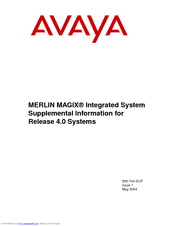Avaya MERLIN MAGIX Manuals
Manuals and User Guides for Avaya MERLIN MAGIX. We have 4 Avaya MERLIN MAGIX manuals available for free PDF download: Maintenance And Troubleshooting Manual, Release Note, Configuration Note, System Programming
Avaya MERLIN MAGIX Maintenance And Troubleshooting Manual (406 pages)
Integrated System Release 2.0 and Earlier
Brand: Avaya
|
Category: Telephone System
|
Size: 3 MB
Table of Contents
Advertisement
Avaya MERLIN MAGIX Release Note (24 pages)
Integrated System Supplemental Information for Release 4.0 Systems
Brand: Avaya
|
Category: Telephone System
|
Size: 0 MB
Table of Contents
Advertisement
Avaya MERLIN MAGIX Configuration Note (12 pages)
Configuration with Octel 100
Advertisement



